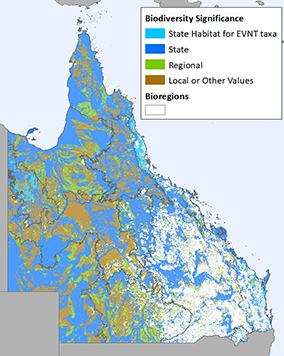Biodiversity planning assessments


A Biodiversity Planning Assessment (BPA) identifies the terrestrial ecological values in a region, or bioregion, according to their conservation significance. BPAs are used by governments, members of the community and landholders to make planning decisions about appropriate land use.
The final BPA, which contains a spatial dataset, expert panel report and summary report (where available), can be accessed using the Queensland Spatial Catalogue website.
(Note: the BPA is a non-social and non-economic assessment, and is produced without regard to land tenure).
A report summarising selected terrestrial and aquatic conservation values as identified by current biodiversity planning assessments and aquatic conservation assessments for a specific location, can be generated through Environmental reports online.
BPAs have been released for approximately 80% of Queensland and these assessments are listed in the table below.
Current Biodiversity Planning Assessments
| Bioregion | Release version | Release date |
|---|---|---|
| Brigalow Belt | 2.1 | 6 March 2018 |
| Cape York Heritage Area | 1.1 | 9 December 2012 |
| Central Qld Coast | 1.3 | 29 January 2007 |
| Channel Country | 1.1 | 30 September 2009 |
| Desert Uplands | 1.3 | 29 June 2012 |
| Einasleigh Uplands | 1.1 | 30 September 2009 |
| Gulf Plains | 1.1 | 25 September 2015 |
| Mitchell Grass Downs | 1.1 | 9 September 2009 |
| Mulga Lands | 1.4 | 15 June 2009 |
| New England Tableland | 2.3 | 18 May 2007 |
| Northwest Highlands | 1.1 | 10 September 2020 |
| Southeast Queensland | 4.1 | 30 September 2016 |
| Wet Tropics | 1.1 | 4 November 2019 |
Each BPA is current until the next version is released. Updated BPAs are released intermittently. For information about previous BPA versions, email biodiversity.planning@des.qld.gov.au.
A visual representation of current BPAs and Queensland bioregions is available in Figure 1 above.
Biodiversity Assessment and Mapping Methodology
The Biodiversity Assessment and Mapping Methodology (BAMM) (PDF, 700KB) is a scientific methodology that provides a consistent approach for assessing biodiversity values at the landscape scale in Queensland. It is the methodology used to generate BPAs for each of Queensland’s bioregions and has been used for ecological values assessment since 2001.
The base layer for analysis is the regional ecosystem mapping from the Queensland Herbarium and the method incorporates a range of biodiversity related data. The BAMM is focused primarily on assessing terrestrial values. Whilst the BAMM includes some wetland values, AquaBAMM provides specific and more detailed information on wetlands values.
The BAMM is applied in two stages. The first stage uses existing data to assess ecological concepts such as rarity, diversity, fragmentation, habitat condition, resilience, threats, and ecosystem processes in a uniform and reliable way across a bioregion. These criteria are used to filter available data and provide an initial determination of significance. This initial assessment is generated through GIS.
The second stage uses expert knowledge to identify features such as wildlife corridors and areas with special biodiversity value (e.g. centres of endemism or wildlife refugia), and includes data that may not be available uniformly across the bioregion. The overall biodiversity significance is a combination of the first and second stage values.
Email biodiversity.planning@des.qld.gov.au for more information.
Available from the library catalogue
The documents referred to on this page are available from the department’s online library catalogue.


